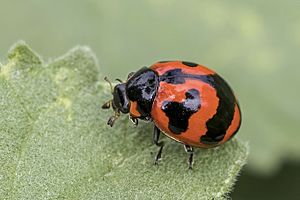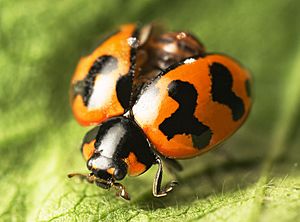Transverse ladybird facts for kids
The transverse ladybird (Coccinella transversalis) is a helpful type of ladybug. You can find these insects in many places, from India all the way across southern and southeastern Asia to Australia. They are sometimes called the transverse lady beetle or the small transverse ladybird. It's important not to confuse them with another ladybug called Coccinella transversoguttata, which lives in Europe and North America.
Quick facts for kids Transverse ladybird |
|
|---|---|
 |
|
 |
|
| Scientific classification | |
| Synonyms | |
|
Contents
What Does the Transverse Ladybird Look Like?
This ladybird is usually about 3.8 to 6.7 millimetres (0.15 to 0.26 in) long. It is also about 3.3 to 5.45 millimetres (0.130 to 0.215 in) wide. These ladybirds look quite similar no matter where they live.
They have a black head. Their wing covers, called elytra, are mostly bright red or orange. These wing covers have a bold black stripe down the middle. They also have two black markings on each side that look a bit like three-leaf clovers.
What Do Transverse Ladybirds Eat?
Like many ladybirds, the transverse ladybird is very important for farming. It helps protect crops by eating many plant-eating insects. These harmful insects can damage plants, especially when they are young.
The transverse ladybird hunts many different kinds of aphids. Aphids are tiny insects that suck sap from plants. Some of the aphids they eat include the pea aphid, cotton aphid, and green peach aphid. They also eat other pests like some types of leafhoppers, scale insects, and even some caterpillars.
How Was This Ladybird Discovered?
The transverse ladybird was first described in 1781. A Danish scientist named Johan Christian Fabricius gave it its scientific name, Coccinella transversalis. This name is still used today.
Fabricius described this ladybird a few months before another scientist, Carl Peter Thunberg, named it C. repanda. Because Fabricius's description came first, his name for the species is the one we use.
See also
 In Spanish: Coccinella transversalis para niños
In Spanish: Coccinella transversalis para niños

